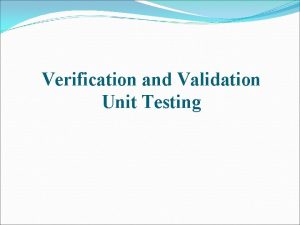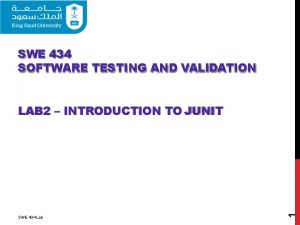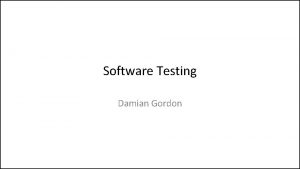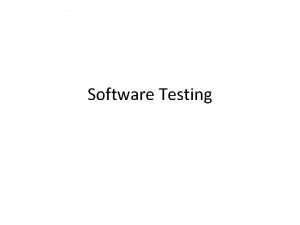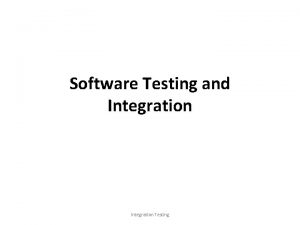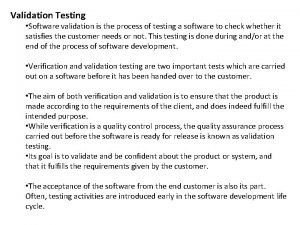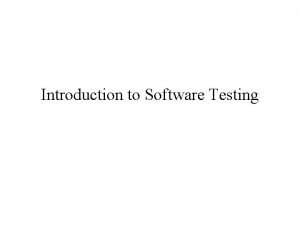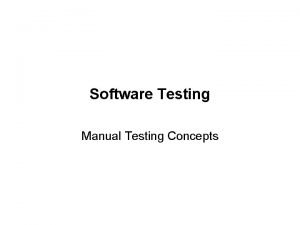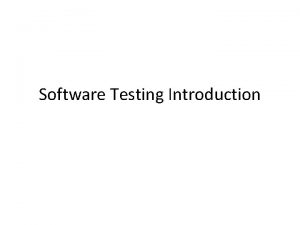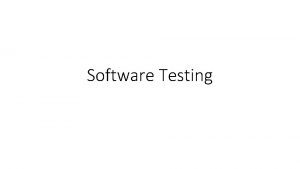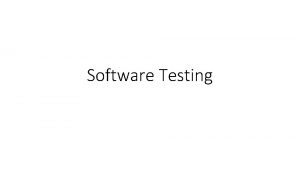SWE 434 SOFTWARE TESTING AND VALIDATION SWE 434













- Slides: 13

SWE 434 SOFTWARE TESTING AND VALIDATION SWE 434 Lab 1 LAB 3 – JUNIT

LAB AGENDA SWE 434 Lab 2 • More Examples and Practice

UNIT TESTING • Required Input and Expected Output. SWE 434 Lab Unit Output 3 Input

TEST CASE VERDICT A verdict is the declared result of executing a single test. We can get the verdict after the assertion statement Pass: the test case achieved its intended purpose, and the software under test performed as expected. Fail: the test case achieved its intended purpose, but the software under test did not perform as expected. SWE 434 Lab 4 Error: the test case did not achieve its intended purpose. Potential reasons: An unexpected event occurred during the test case. The test case could not be set up properly

JUNIT METHODS • assert. Array. Equals() • Test whether two arrays are equal to each other. In other words, if the two arrays contain the same number of elements, and if all the elements in the array are equal to each other. • assert. True() + assert. False() • The assert. True() and assert. False() methods tests a single expression to see if its value is either true, or false. assert. Null() + assert. Not. Null() SWE 434 Lab 5 • The assert. Null() and assert. Not. Null() methods test a single variable to see if it is null or not null

SWE 434 Lab 6 EXAMPLE

EXCEPTION IN JUNIT Add parameter to @Test annotation, indicating that a particular class of exception is expected to occur during the test • Useful for simple cases, but it has its limits: SWE 434 Lab 7 • you can't test the value of the message in the exception, or the state of a domain object after the exception has been thrown.

EXCEPTION IN JUNIT ● Catch exception, and use fail( ) if not thrown: Try{ Method. To. Be. Tested() fail(“Message”) } Catch(Exception. Type E){ SWE 434 Lab 8 }

SWE 434 Lab 9 EXAMPLE

• For a collection of tests for a particular class, there are often some repeated tasks that must be done prior to each test case or after the end of each use cases: • Set up connection • Database • Clean up • Reset data • Ensures resources are released, test system is in known state for next test case, etc. Since a test case failure ends execution of a test method at that point, code to clean up cannot be at the end of the method. • SWE 434 Lab 10 SETUP AND TEARDOWN

SETUP AND TEARDOWN • Setup: Use the @Before annotation on a method containing code to run before each test case. • Teardown: Use the @After annotation on a method containing code to run after each test case. SWE 434 Lab 11 • These methods will run even if exceptions are thrown in the test case or an assertion fails.

• Setup Once: Use the @Before. Class to run a method once only for the entire test class, before any of the tests are executed, and prior to any @Before method(s) • Teardown Once: Use the @After. Class annotation to run after all test case methods in the class have been executed, and after any @After methods • Useful for starting servers, opening communications, etc. that are time-consuming to close and re-open for each test. SWE 434 Lab 12 SETUP AND TEARDOWN ONCE

SWE 434 Lab 13 SETUP AND TEARDOWN
 Pega express testing and validation
Pega express testing and validation Domain closure in software testing
Domain closure in software testing Motivational overview in software testing
Motivational overview in software testing Du path testing
Du path testing Globalization testing example
Globalization testing example Cause effect graphing technique
Cause effect graphing technique Control structure testing in software testing
Control structure testing in software testing Decision table testing in software testing
Decision table testing in software testing Decision table advantages and disadvantages
Decision table advantages and disadvantages Decision table for next date problem
Decision table for next date problem Rigorous testing in software testing
Rigorous testing in software testing Testing blindness in software testing
Testing blindness in software testing Software domain examples
Software domain examples Is unit testing verification or validation
Is unit testing verification or validation













